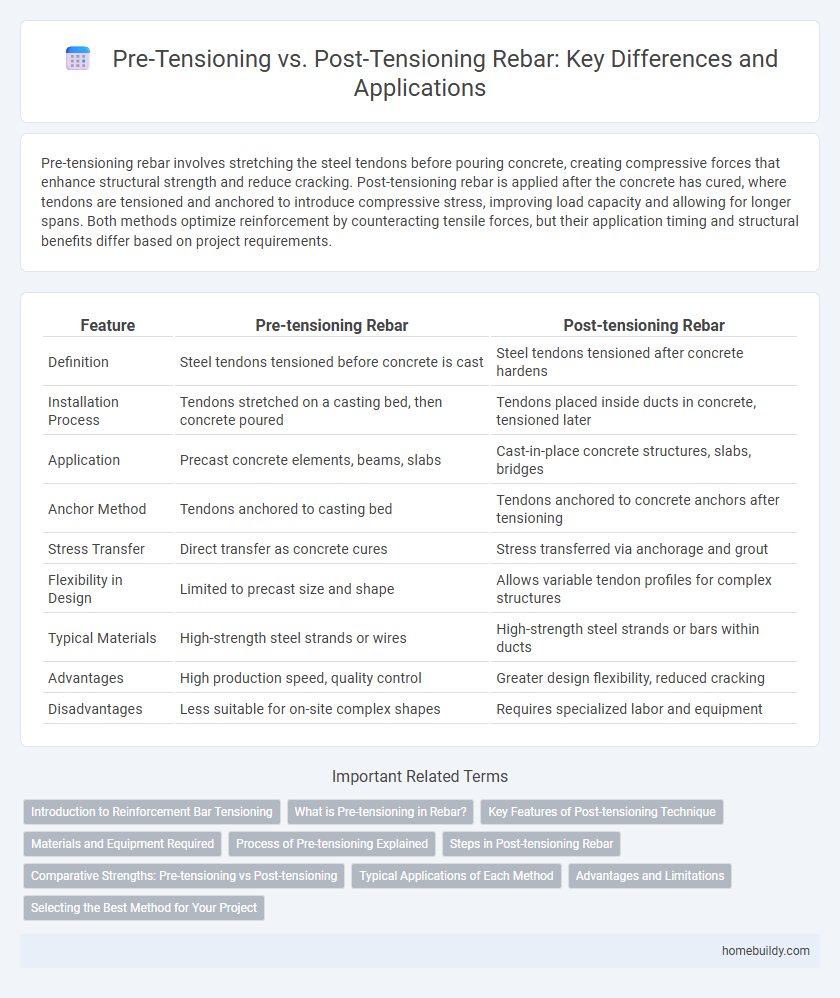Pre-tensioning rebar involves stretching the steel tendons before pouring concrete, creating compressive forces that enhance structural strength and reduce cracking. Post-tensioning rebar is applied after the concrete has cured, where tendons are tensioned and anchored to introduce compressive stress, improving load capacity and allowing for longer spans. Both methods optimize reinforcement by counteracting tensile forces, but their application timing and structural benefits differ based on project requirements.
Table of Comparison
| Feature | Pre-tensioning Rebar | Post-tensioning Rebar |
|---|---|---|
| Definition | Steel tendons tensioned before concrete is cast | Steel tendons tensioned after concrete hardens |
| Installation Process | Tendons stretched on a casting bed, then concrete poured | Tendons placed inside ducts in concrete, tensioned later |
| Application | Precast concrete elements, beams, slabs | Cast-in-place concrete structures, slabs, bridges |
| Anchor Method | Tendons anchored to casting bed | Tendons anchored to concrete anchors after tensioning |
| Stress Transfer | Direct transfer as concrete cures | Stress transferred via anchorage and grout |
| Flexibility in Design | Limited to precast size and shape | Allows variable tendon profiles for complex structures |
| Typical Materials | High-strength steel strands or wires | High-strength steel strands or bars within ducts |
| Advantages | High production speed, quality control | Greater design flexibility, reduced cracking |
| Disadvantages | Less suitable for on-site complex shapes | Requires specialized labor and equipment |
Introduction to Reinforcement Bar Tensioning
Pre-tensioning and post-tensioning are two primary methods used for applying tension to reinforcement bars in concrete structures, enhancing their load-bearing capacity and crack resistance. Pre-tensioning involves stretching the rebar before concrete placement, ensuring immediate composite action once the concrete sets, while post-tensioning requires tensioning the rebar after the concrete has hardened, allowing for adjustable stress application. Both techniques optimize reinforcement bar performance but differ in timing and construction process, influencing structural behavior and durability.
What is Pre-tensioning in Rebar?
Pre-tensioning in rebar involves tensioning the steel strands before concrete is poured, creating a strong bond as the concrete hardens around the stressed steel. This method enhances structural integrity by introducing compressive forces that counteract tensile stresses, improving crack resistance and load-bearing capacity. Commonly used in precast concrete elements, pre-tensioning optimizes reinforcement efficiency and accelerates construction timelines.
Key Features of Post-tensioning Technique
Post-tensioning rebar involves tensioning high-strength steel tendons after concrete has cured, allowing for greater load capacity and reduced concrete thickness. It offers enhanced crack control and improved structural performance through active compressive forces, optimizing material efficiency. This technique is widely used in bridges, slabs, and large-span structures due to its superior flexibility and durability compared to pre-tensioning.
Materials and Equipment Required
Pre-tensioning rebar involves high-strength steel strands or wires stretched in a casting bed before concrete is poured, requiring robust anchoring devices and hydraulic jacks to apply tension. Post-tensioning rebar uses ducts embedded in the concrete through which tendons are threaded and tensioned after concrete hardening, necessitating hydraulic jacks, anchorages, and grouting equipment to secure and protect the tendons. Both methods utilize specialized high-tensile steel materials but differ significantly in installation equipment and sequence to achieve optimal structural reinforcement.
Process of Pre-tensioning Explained
Pre-tensioning involves stretching high-strength steel reinforcing bars before concrete is poured, anchoring the tensioned bars to a rigid frame. Once the concrete hardens, the tension is released, transferring compressive forces to the concrete structure for enhanced strength and crack resistance. This process ensures improved load-bearing capacity and durability in precast concrete elements.
Steps in Post-tensioning Rebar
Post-tensioning rebar involves threading high-strength tendons through ducts embedded in concrete, followed by casting the concrete around these ducts. Once the concrete attains the required strength, hydraulic jacks apply tension to the tendons, anchoring them firmly at the ends to induce compressive stresses in the concrete. This method enhances structural performance by controlling cracking and improving load-bearing capacity compared to pre-tensioning techniques.
Comparative Strengths: Pre-tensioning vs Post-tensioning
Pre-tensioning rebar involves tensioning the steel before concrete placement, resulting in high initial load capacity and reduced cracking under service loads. Post-tensioning rebar is tensioned after concrete hardens, allowing greater adaptability in structural design and improved performance under dynamic or variable loads. Pre-tensioning excels in standardized, repetitive elements, while post-tensioning offers superior flexibility and enhanced structural efficiency for longer spans.
Typical Applications of Each Method
Pre-tensioning rebar is commonly used in precast concrete elements such as beams, slabs, and railway sleepers, where the reinforcement is tensioned before the concrete is poured and gains strength. Post-tensioning rebar is typical in cast-in-place concrete structures like bridges, parking garages, and high-rise buildings, allowing for longer spans and reduced crack widths by applying tension after concrete hardening. Each method optimizes structural performance based on the construction process and load requirements, with pre-tensioning suited for factory-controlled environments and post-tensioning ideal for on-site adaptability.
Advantages and Limitations
Pre-tensioning rebar enhances concrete strength through early tensioning, resulting in high load-carrying capacity and reduced cracking, but requires specialized setups limiting its application to precast elements. Post-tensioning rebar offers flexibility in design and can be applied on-site, enabling longer spans and thinner slabs, though it demands careful tensioning control and maintenance to prevent corrosion. Both methods improve structural performance but differ in installation complexity, cost, and adaptability to project requirements.
Selecting the Best Method for Your Project
Pre-tensioning rebar involves stretching steel tendons before concrete placement, offering high initial strength and reduced cracking in precast elements. Post-tensioning rebar, applied after concrete curing, allows greater design flexibility and is ideal for longer spans and complex structures. Selecting the best method depends on factors like project size, structural requirements, and construction schedule for optimal durability and cost-efficiency.
Pre-tensioning vs Post-tensioning rebar Infographic

 homebuildy.com
homebuildy.com